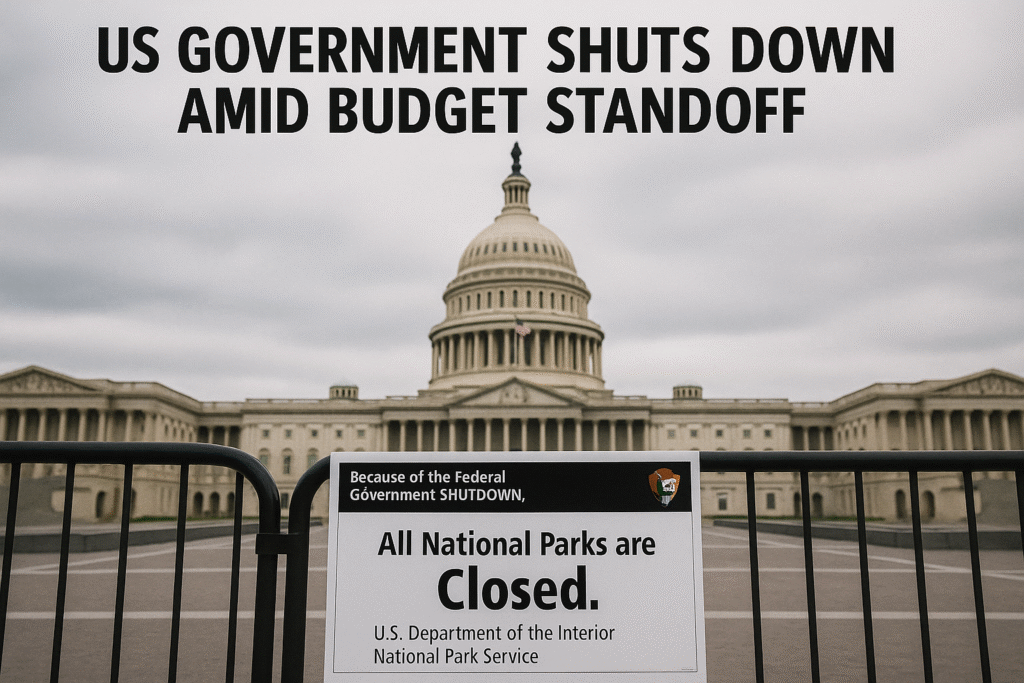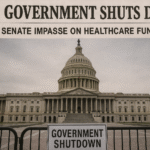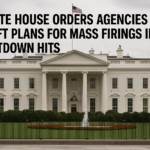By Harshit, October 1, 2025 | Washington D.C. 6:30 AM EDT
The US federal government officially shut down on Wednesday after Republicans and Democrats failed to resolve a budget impasse, leaving hundreds of thousands of federal employees without pay and threatening wide-ranging disruptions across the country. The funding stalemate affects government operations through October and could extend further if lawmakers fail to reach an agreement.
Federal Workers Face Unpaid Leave
Approximately 40% of the federal workforce—around 800,000 employees—will be placed on unpaid leave. While some workers deemed “essential,” including air traffic controllers and TSA staff, must continue reporting to work, they will not receive pay until the shutdown ends. During the 2018–2019 shutdown, similar circumstances led to absenteeism and long airport delays, raising concerns about the potential for repeated disruptions in air travel.
Non-essential federal employees will be forced to stay home and, historically, have been paid retroactively once funding resumes. Contractors working for federal agencies will also lose pay, with most unable to claim backpay during past shutdowns.
Impact on Travel and Public Services
Travelers could face delays in processing US passports, as agencies struggle with reduced staff. Airports may experience longer security queues, particularly if essential staff call in sick.
National Parks and federal lands are also at risk. In past shutdowns, parks left open without staffing suffered vandalism and damage. More than 40 former park superintendents have urged the White House to close parks completely during a shutdown. In Washington DC, the Smithsonian Institution will remain open until at least October 6, using funds from prior years to maintain operations. The National Zoo, managed by the Smithsonian, will continue feeding and caring for animals, though its live webcams will be shut off.
Health Care and Social Services
Medicare and Medicaid services for the elderly and low-income Americans will continue, but staff shortages may cause interruptions. Emergency disaster relief is largely expected to operate normally, though other administrative functions will be limited.
Programs such as the National Flood Insurance Program may halt operations, delaying mortgage approvals that rely on government-backed insurance. Food assistance programs face risks: the Supplemental Nutrition Program for Women, Infants, and Children (WIC) is likely to deplete funds quickly, while the Supplemental Nutrition Assistance Program (SNAP) could continue for a longer period but remains vulnerable to extended funding gaps.
Potential Long-Term Consequences
President Donald Trump, who has reduced federal spending and cut government jobs since taking office, has warned that the shutdown could accelerate layoffs and allow him to eliminate programs he claims are Democratic priorities. Analysts warn that extended shutdowns could disrupt ongoing research at institutions like the Centers for Disease Control and Prevention (CDC) and the National Institutes of Health (NIH), delaying experiments and health studies crucial to public safety.
Contractors, who do not receive federal backpay, will face financial strain, and many federal workers may take second jobs to cope with the income loss.
Public Reaction and Outlook
The shutdown has sparked concern nationwide, with citizens bracing for impacts on air travel, healthcare, and access to federal lands. As lawmakers continue negotiations, the duration of the shutdown remains uncertain. Historically, the party initiating a shutdown struggles to achieve its objectives, and public opinion often pressures Congress to restore funding.
With critical services disrupted and millions of Americans affected, the political stalemate underscores the fragility of the US budget process and highlights the real-world consequences of legislative gridlock.







